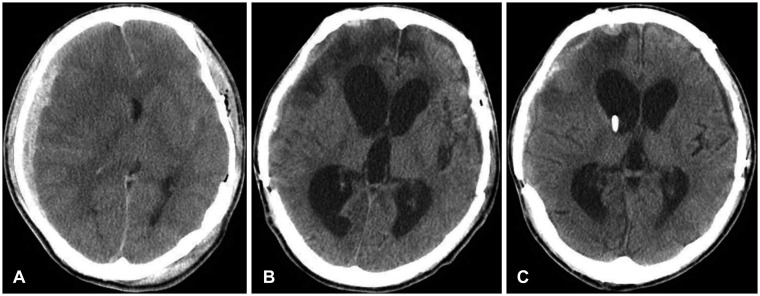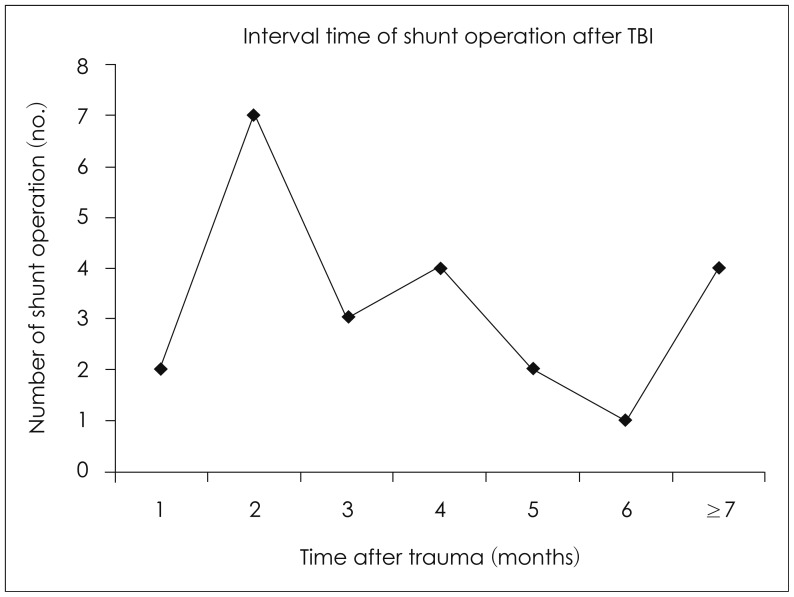Korean J Neurotrauma.
2015 Oct;11(2):58-62. 10.13004/kjnt.2015.11.2.58.
Clinical Analysis of Results of Shunt Operation for Hydrocephalus Following Traumatic Brain Injury
- Affiliations
-
- 1Department of Neurosurgery, Wallace Memorial Baptist Hospital, Busan, Korea. lsuon@korea.com
- 2Department of Neurosurgery, Haedong Hospital, Busan, Korea.
- 3Department of Neurosurgery, Busan Veterans Hospital, Busan, Korea.
- KMID: 2378259
- DOI: http://doi.org/10.13004/kjnt.2015.11.2.58
Abstract
OBJECTIVE
Ventricular enlargement following head injury is a frequent finding but cases requiring shunt operation are rare. The incidence and developing factors of post-traumatic hydrocephalus (PTH) have been variously reported, but studies for factors influencing outcomes of shunt operation for PTH are rare. The incidence of PTH requiring shunt operation, causing injuries, and factors influencing outcome of shunt operation need to be identified.
METHODS
In total, 1,142 patients suffering from traumatic brain injury (TBI) between January 2007 and December 2012 were admitted to our department. Of them, 23 patients underwent shunt operation for diagnosed PTH. In this clinical study, we reviewed retrospectively our TBI database and in the 23 patients, we evaluated outcomes with Glasgow Outcome Score just before the operation, at 14 days, 3 months, and 6 months according to initial Glasgow Coma Scale (GCS) score, interval time between shunt operation and trauma, and lumbar cerebrospinal fluid (CSF) pressure.
RESULTS
The incidence of PTH treated with shunt operation was 2.01%. Subdural hematoma (SDH) was the most common preceding head injury. The outcomes of shunt operation were not related with lumbar CSF pressure or interval time from trauma, but initial GCS score correlated with the outcome.
CONCLUSION
In present study, 2.01% of TBI patients underwent shunt operation. SDH was the most common preceding injury. Admission GCS score was related to the outcome of shunt operation. However, there were no correlation between the outcome of shunt operation and initial lumbar CSF pressure or interval time of shunt operation after the trauma.
Keyword
MeSH Terms
Figure
Cited by 1 articles
-
Introduction to the Korean Neurotrauma Data Bank System and Report on the Results of the Second Project
Ji-Na Kim, Ki Seong Eom
J Korean Neurosurg Soc. 2025;68(1):25-36. doi: 10.3340/jkns.2024.0156.
Reference
-
1. Beyerl B, Black PM. Posttraumatic hydrocephalus. Neurosurgery. 1984; 15:257–261. PMID: 6384812.
Article2. Bret P, Hor F, Huppert J, Lapras C, Fischer G. Treatment of cerebrospinal fluid rhinorrhea by percutaneous lumboperitoneal shunting: review of 15 cases. Neurosurgery. 1985; 16:44–47. PMID: 3974811.
Article3. Cardoso ER, Galbraith S. Posttraumatic hydrocephalus--a retrospective review. Surg Neurol. 1985; 23:261–264. PMID: 3975808.
Article4. Choi I, Park HK, Chang JC, Cho SJ, Choi SK, Byun BJ. Clinical factors for the development of posttraumatic hydrocephalus after decompressive craniectomy. J Korean Neurosurg Soc. 2008; 43:227–231. PMID: 19096601.
Article5. Chuang K, Stroud NL, Zafonte R. Rehabilitation of patients with traumatic brain injury. In : Winn HR, editor. Youmans neurological surgery. ed 6. Phildelphia, PA: Elsevier Saunders;2011. p. 3516–3534. p. e3511–e3513.6. Dandy WE, Blackfan KD. Internal hydrocephalus. An experimental, clinical and pathological study. J Neurosurg. 1964; 21:588–635.7. Foltz EL, Ward AA Jr. Communicating hydrocephalus from subarachnoid bleeding. J Neurosurg. 1956; 13:546–566. PMID: 13377208.
Article8. Foroglou G, Zander E. [Post-traumatic hydrocephalus and measurement of cerebrospinal fluid pressure]. Acta Radiol Diagn (Stockh). 1972; 13:524–530. PMID: 4670773.9. Groswasser Z, Cohen M, Reider-Groswasser I, Stern MJ. Incidence, CT findings and rehabilitation outcome of patients with communicative hydrocephalus following severe head injury. Brain Inj. 1988; 2:267–272. PMID: 3203174.
Article10. Gudeman SK, Kishore PR, Becker DP, Lipper MH, Girevendulis AK, Jeffries BF, et al. Computed tomography in the evaluation of incidence and significance of post-traumatic hydrocephalus. Radiology. 1981; 141:397–402. PMID: 6974874.
Article11. Guyot LL, Michael DB. Post-traumatic hydrocephalus. Neurol Res. 2000; 22:25–28. PMID: 10672577.
Article12. Hawkins TD, Lloyd AD, Fletcher GI, Hanka R. Ventricular size following head injury: a clinico-radiological study. Clin Radiol. 1976; 27:279–289. PMID: 1086181.
Article13. Khan QU, Wharen RE, Grewal SS, Thomas CS, Deen HG Jr, Reimer R, et al. Overdrainage shunt complications in idiopathic normal-pressure hydrocephalus and lumbar puncture opening pressure. J Neurosurg. 2013; 119:1498–1502. PMID: 23930853.
Article14. Kim SW, Lee SM, Shin H. Clinical Analysis of Post-traumatic Hydrocephalus. J Korean Neurosurg Soc. 2005; 38:211–214.15. Kishore PR, Lipper MH, Miller JD, Girevendulis AK, Becker DP, Vines FS. Post-traumatic hydrocephalus in patients with severe head injury. Neuroradiology. 1978; 16:261–265. PMID: 740188.
Article16. Marmarou A, Foda MA, Bandoh K, Yoshihara M, Yamamoto T, Tsuji O, et al. Posttraumatic ventriculomegaly: hydrocephalus or atrophy? A new approach for diagnosis using CSF dynamics. J Neurosurg. 1996; 85:1026–1035. PMID: 8929491.
Article17. Pedersen KK, Haase J. Isotope liquorgraphy in the demonstration of communicating obstructive hydrocephalus after severe cranial trauma. Acta Neurol Scand. 1973; 49:10–30. PMID: 4684587.
Article18. Philippon J, George B, Visot A, Cophignon J. [Post-operative hydrocephalus]. Neurochirurgie. 1976; 22:111–117. PMID: 1012410.19. Sheffler LR, Ito VY, Philip PA, Sahgal V. Shunting in chronic post-traumatic hydrocephalus: demonstration of neurophysiologic improvement. Arch Phys Med Rehabil. 1994; 75:338–341. PMID: 8129589.
Article20. Tribl G, Oder W. Outcome after shunt implantation in severe head injury with post-traumatic hydrocephalus. Brain Inj. 2000; 14:345–354. PMID: 10815842.
- Full Text Links
- Actions
-
Cited
- CITED
-
- Close
- Share
- Similar articles
-
- Clinical Analysis of Post-traumatic Hydrocephalus
- Clinical Analysis of Hydrocephalus Patients Who Underwent Shunt Surgery after Traumatic Brain Injury
- Asymptomatic Fracture of a Distal Shunt Catheter after Ventriculoperitoneal Shunt for Post-traumatic Hydrocephalus
- Clinical Study of Post-traumatic Normal Pressure Hydrocephalus
- A Reappraisal of the Necessity of a Ventriculoperitoneal Shunt After Decompressive Craniectomy in Traumatic Brain Injury



